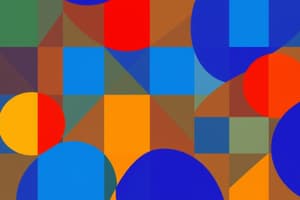Podcast
Questions and Answers
What type of personal accessory is the individual wearing in the image?
What type of personal accessory is the individual wearing in the image?
- Bracelet
- Earrings
- Necklace
- Nose piercing (correct)
Which of the following best describes the lighting conditions in the image?
Which of the following best describes the lighting conditions in the image?
- Harsh and direct, creating strong shadows
- Balanced and even, with natural tones
- Soft and diffused, with minimal shadows (correct)
- Artificial and warm, with a yellow tint
What is the predominant color of the individual's shirt?
What is the predominant color of the individual's shirt?
- Yellow
- Red (correct)
- Blue
- Green
What is the relative position of the camera to the subject in this image?
What is the relative position of the camera to the subject in this image?
What is the subject doing with their hand?
What is the subject doing with their hand?
What type of object is visible on the ceiling in the background?
What type of object is visible on the ceiling in the background?
What is the general style or pattern of the cloth seen in the background?
What is the general style or pattern of the cloth seen in the background?
Which of the following elements indicates the setting might be indoors?
Which of the following elements indicates the setting might be indoors?
What is the prominent facial expression displayed by the individual in the image?
What is the prominent facial expression displayed by the individual in the image?
What can be inferred about the individual's hair?
What can be inferred about the individual's hair?
What does the presence of a window with visible panes imply about the location?
What does the presence of a window with visible panes imply about the location?
Which of the following describes the overall quality of the image?
Which of the following describes the overall quality of the image?
What is the most likely purpose of this image?
What is the most likely purpose of this image?
What level of detail is noticeable in the background elements?
What level of detail is noticeable in the background elements?
How would you describe the color saturation in the image?
How would you describe the color saturation in the image?
What does the color of the window frame most likely suggest about its material?
What does the color of the window frame most likely suggest about its material?
Based on the angle and focus, what area is the primary subject of the photo?
Based on the angle and focus, what area is the primary subject of the photo?
What inference can be made from the state of the ceiling?
What inference can be made from the state of the ceiling?
The image includes a window. What does this suggest about the time of day it was taken?
The image includes a window. What does this suggest about the time of day it was taken?
What is the level of formality presented in the picture?
What is the level of formality presented in the picture?
Flashcards
Nose piercing
Nose piercing
A piercing through the nose, often adorned with jewelry.
Ceiling Fan
Ceiling Fan
A device with rotating blades to circulate air.
Study Notes
Orthogonal Complement
- For a subspace ( W ) of a vector space ( V ), the orthogonal complement of ( W ) includes every vector in ( V ) that is orthogonal to all vectors in ( W ).
- ( W^{\perp}={v \in V \mid\langle v, w\rangle=0 \text { for all } w \in W} ) defines the orthogonal complement of ( W ).
- ( W^{\perp} ) forms a subspace.
- The orthogonal complement of the orthogonal complement of ( W ) is ( W ), denoted as ( \left(W^{\perp}\right)^{\perp}=W ).
- The intersection of ( W ) and ( W^{\perp} ) contains only the zero vector: ( W \cap W^{\perp}={0} ).
Orthogonal Projection
- Any vector ( v ) in ( V ) can be uniquely expressed as the sum of two vectors ( w ) and ( u ), where ( w ) is in ( W ) and ( u ) is in ( W^{\perp} ).
- Orthogonal projection of ( v ) onto ( W ) is vector ( w ), which is denoted as ( w=\operatorname{proj}_{W}(v) ).
- For ( V=\mathbb{R}^{2} ) and ( W=\operatorname{span}\left{\left[\begin{array}{l}1 \ 1\end{array}\right]\right} ), to find ( \operatorname{proj}_{w}\left(\left[\begin{array}{l}2 \ 4\end{array}\right]\right) ):
- Express ( \left[\begin{array}{l}2 \ 4\end{array}\right] ) as ( w+u ), where ( w \in W ) and ( u \in W^{\perp} ).
- Set ( w=\alpha\left[\begin{array}{l}1 \ 1\end{array}\right] ) and ( u=\left[\begin{array}{c}u_{1} \ u_{2}\end{array}\right] ).
- Since ( \left\langle\left[\begin{array}{l}1 \ 1\end{array}\right],\left[\begin{array}{l}u_{1} \ u_{2}\end{array}\right]\right\rangle=0 ), then ( u_{1}+u_{2}=0 ), leading to ( u_{2}=-u_{1} ).
- Solve ( \left[\begin{array}{l}2 \ 4\end{array}\right]=\left[\begin{array}{l}\alpha \ \alpha\end{array}\right]+\left[\begin{array}{c}u_{1} \ -u_{1}\end{array}\right] ) to find ( \alpha=3 ) and ( u_{1}=-1 ).
- ( w=3\left[\begin{array}{l}1 \ 1\end{array}\right]=\left[\begin{array}{l}3 \ 3\end{array}\right] ), so ( \operatorname{proj}_{w}\left(\left[\begin{array}{l}2 \ 4\end{array}\right]\right)=\left[\begin{array}{l}3 \ 3\end{array}\right] ).
Gram-Schmidt Process
- The Gram-Schmidt process transforms a basis ( \left{v_{1}, \ldots, v_{k}\right} ) of ( W ) into an orthogonal basis ( \left{w_{1}, \ldots, w_{k}\right} ) of ( W ).
- Set ( w_{1}=v_{1} ).
- Calculate subsequent vectors using the formula ( w_{i}=v_{i}-\operatorname{proj}{\text {span }\left{w{1}, \ldots, w_{i-1}\right}}\left(v_{i}\right) ).
- For all ( i ), ( \operatorname{span}\left{w_{1}, \ldots, w_{i}\right} ) is equal to ( \operatorname{span}\left{v_{1}, \ldots, v_{i}\right} ).
Gram-Schmidt Example
- For ( V=\mathbb{R}^{3} ) and ( W=\operatorname{span}\left{\left[\begin{array}{l}1 \ 1 \ 1\end{array}\right],\left[\begin{array}{l}0 \ 1 \ 1\end{array}\right]\right} ), the orthogonal basis of ( W ) is found as follows:
- Set ( w_{1}=v_{1}=\left[\begin{array}{l}1 \ 1 \ 1\end{array}\right] ).
- Calculate ( w_{2}=v_{2}-\operatorname{proj}{\text {span }\left{w{1}\right}}\left(v_{2}\right) ).
- ( \operatorname{proj}{\text {span }\left{w{1}\right}}\left(v_{2}\right)=\frac{\left\langle v_{2}, w_{1}\right\rangle}{\left\langle w_{1}, w_{1}\right\rangle} w_{1}=\frac{2}{3}\left[\begin{array}{l}1 \ 1 \ 1\end{array}\right] ).
- ( w_{2}=\left[\begin{array}{l}0 \ 1 \ 1\end{array}\right]-\frac{2}{3}\left[\begin{array}{l}1 \ 1 \ 1\end{array}\right]=\left[\begin{array}{c}-\frac{2}{3} \ \frac{1}{3} \ \frac{1}{3}\end{array}\right] ).
- The orthogonal basis of ( W ) is ( \left{w_{1}, w_{2}\right}=\left{\left[\begin{array}{l}1 \ 1 \ 1\end{array}\right],\left[\begin{array}{c}-\frac{2}{3} \ \frac{1}{3} \ \frac{1}{3}\end{array}\right]\right} ).
Studying That Suits You
Use AI to generate personalized quizzes and flashcards to suit your learning preferences.




